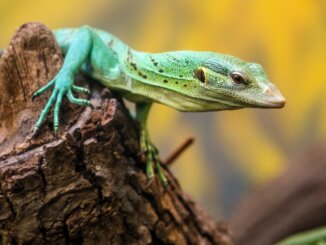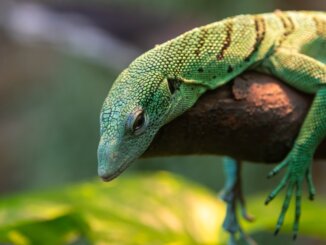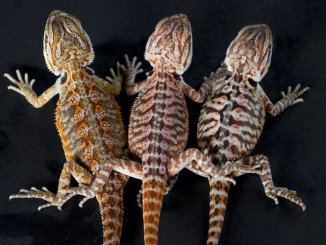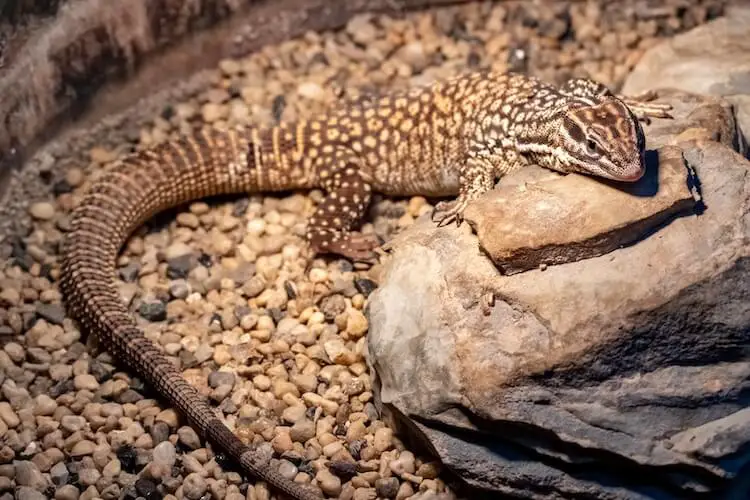
Monitors are infamous for being large lizards that are difficult to care for. Many are only suitable for advanced keepers. Yet, not all monitor lizards are giant sized and hard to keep.
The Ackie monitor is one of the smallest and friendliest monitors.
Ackies keep the eye-catching beauty of a monitor lizard whilst being easy to care for. Their size also makes them suitable for intermediate keepers who want to hold them.
Sometimes known as the spiny tailed monitor, this species is related larger reptiles like the Nile monitor and Komodo dragon.
Are you interested by the intelligence and beauty of an Ackies monitor? Are you also prepared to invest the time and effort it takes to care for one? Keep reading for our care sheet, cage setup and enrichment ideas…
About Ackie Monitors
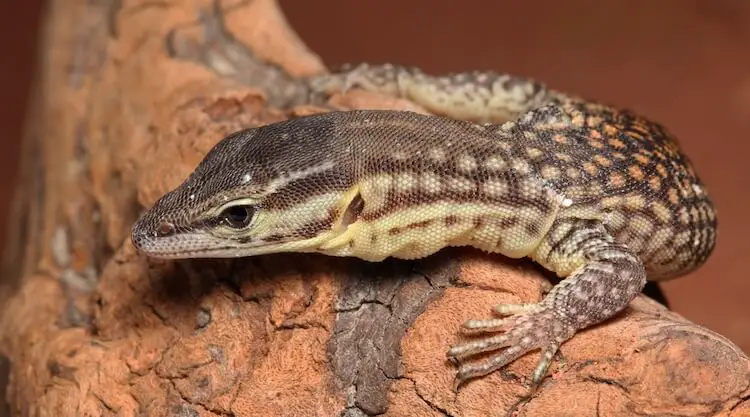
Ackie monitors (Varanus acanthurus) are found in northwest Australia where they share a habitat with kangaroos, camels, and other monitor lizards. This species belongs to the Varanidae family of lizards which also includes the famous Komodo dragon. Part of the reason many people adopt them is because Ackies look like miniature Komodo dragons!
Ackie monitors were first described and named by Belgian zoologist George Albert Boulenger in 1885.
They have actually been in existence for thousands of years before 1885. Some estimates date Ackie monitors at two million years old. Despite their ancient history, Ackies have only recently become popular pets.
There are two subspecies of Ackie monitor that can be kept as pets:
- The Red Ackie (Varanus acanthurus acanthurus)
- The Yellow Ackie (Varanus acanthurus brachyurus)
Yellow Ackies are slightly shorter than red individuals, but their care is identical. These lizards typically only grow to two feet long, with their tails taking up most of the size. They are also known as spiny tailed monitors because their tails are covered in sharp, spinose scales that can be used as a club.
Red individuals have a beautiful rusty brown color with pale spots down their legs and back. They have long, slender heads with two white stripes that run from the tip of their snout to the base of the neck.
Are Ackie Monitors Good For Beginners?
Ackie Monitors are friendlier, smaller and easier to care for than many other types of Monitor lizard. Their intelligent nature also makes Ackies loved by many reptile enthusiasts. But, while Ackie monitors are one of the easiest monitor lizards to care for, they are not a lizard for beginners.
Ackies monitors are a big responsibility.
These lizards can live for 20 years and require at least a 120-gallon tank with two feet of loose substrate. As an active species that climbs and digs plenty of décor is needed for enrichment. Branches, logs, cardboard boxes, rocks, and plywood can all withstand an Ackie’s explorations.
If you are willing to put in the time and money it takes to care for one, they are one of the best and most rewarding reptiles for intermediate and advanced keepers.
How Much Does An Ackie Monitor Cost?
Ackies monitors are not cheap and cost between $500 and $1,000. Their price depends on age, color and breeder. You will also need to budget $1,000 for a 120-gallon tank setup.
You will need to be prepared to spend upwards of several thousand dollars over their lifetime on substrate, lighting, healthcare and food. They should never be an impulse purchase.
The Ackie is not a good choice for someone with a tight or even moderate budget. Blue-Tongued Skinks are a much better choice for intermediate keepers on a smaller budget.
Wild populations of Ackie Monitors are not in danger of extinction, but nearly all individuals sold as pets are captive bred. They are rarely found in pet stores, but are widely available at exotic animal shows and from online breeders.
It is best to buy in person so you can look at their temperament, behavior and appetite. Be aware, those displayed at busy reptile shows may be temporarily stressed.
Purchasing a healthy Ackie Monitor can prevent many health problems. Healthy individuals are bright, quick, and alert, with a good feeding response. Avoid any pets that are unresponsive, have damaged toes or have patches of retained shed stuck.
Appearance
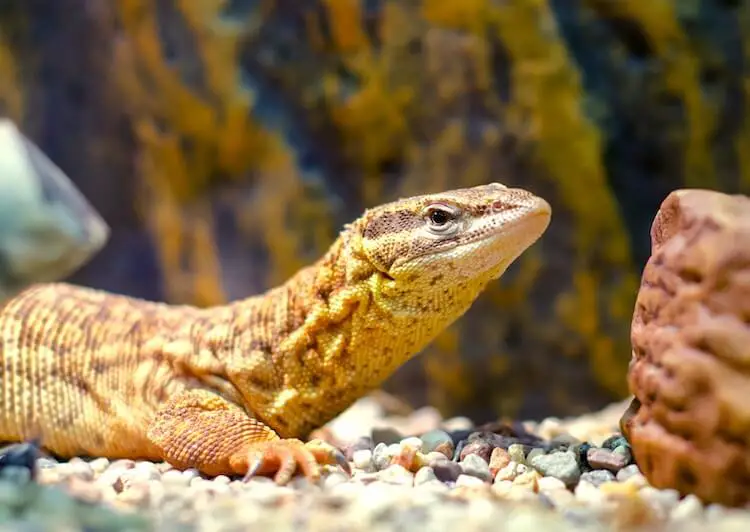
Ackie monitors are beautiful that at first glance can look like miniature Komodo dragons. They have pointed heads with large eyes, prominent ear openings, and a spiny tail.
As their other name (the “spiny tailed” lizard) suggests, they have very long tails covered in rows of sharp scales. Their tails can be twice as long as the rest of their body. The rest of their body is made up of small round scales that protect them from the heat and dry conditions in Australia.
There are three known subspecies of Ackie monitor, of which only two are commonly kept as pets:
- The Island ackie (V. acanthurus insulanicus) is very rare and is not normally sold as a pet.
- The Yellow Ackie (V. acanthurus brachyurus) is the most popular subspecies.
- The Red Ackie (V. acanthurus acanthurus) is the largest of the three.
Yellow Ackies have a slightly shorter tail than red monitors. They are dark brown or black with bright yellow spots and a white and black tail. Many yellow monitors have a more distinctly striped face and neck when compared to their red cousins.
Red subspecies are a rusty red color with a cream belly and white or yellow rosettes along their back. Their tails have alternating white and brown bands, which may break up into a checkered pattern. They have two white stripes along each side of their face, with a dark stripe through the eye.
Hatchlings are normally four or five inches long and grow to their full size in two years. Adults reach 24 to 30 inches and can weigh anywhere from 5 to 12 ounces.
Unlike Bearded Dragons that are very easy to sex, there are very few differences between male and female Ackie Monitors. Males have slightly broader heads, though this is very difficult to see unless you compare your monitor to an already sexed adult.
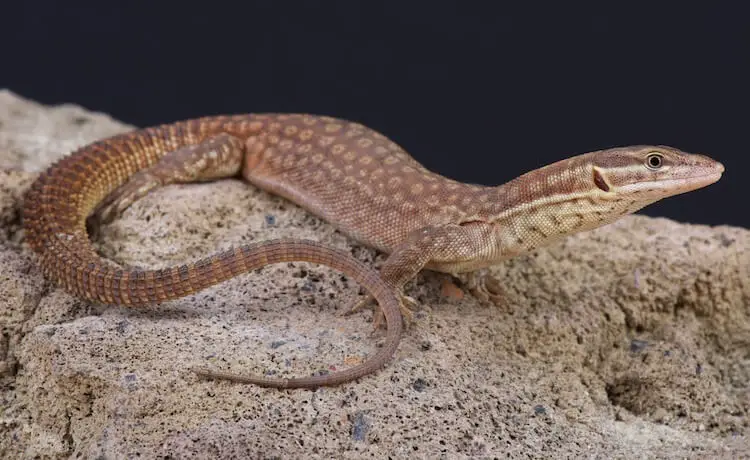
How To Build An Ackie Monitor Cage
Bigger is always better when it comes to cage sizes for Ackie monitors. This monitor needs a lot of space to be comfortable. At a minimum, adults need a 120-gallon tank and juveniles can be kept in smaller 40-gallon enclosures as it helps them to feel secure.
Ackie monitors also like their cage to be hot!
They need a basking spot in their enclosure with a surface temperature of 120 to 150°F. The cooler side should have an ambient temperatures of 80 to 85°F. As daytime lizards, Ackies also need a UVB light to metabolize calcium. A high-output, 26-Watt UVB bulb should be used for 12 hours a day and replaced every six months.
These lizards also need a relatively high humidity. Keep their enclosure between 65 and 85% humidity by misting the substrate with a spray bottle multiple times a day. The substrate should be slightly damp, so it retains its shape when dug into, but not so wet that it feels soggy.
Too much moisture can lead to skin infections, so make sure you use a thermometer and hygrometer.
As with any pet lizard, always provide them with clean water on the cool side of their enclosure. Empty and refill the bowl daily with water free from chlorine and other contaminants.
Make sure to use a bowl that fits your Ackie’s body. While they do not swim, they will soak occasionally when shedding.
Décor and Substrate
Ackie monitors come from the dry scrublands of northwest Australia. These scrublands are mostly open fields covered in grass, tumbleweed, rock outcroppings and trees. They spend their day hunting for small animals among the tumbleweed and rocks. At night they sleep in the shelter of boulders.
Substrate and décor are very important to a good Ackie Monitor setup.
These diggers need two feet of loose substrate to burrow in. They also need plenty of sticks, logs, plants, and hides to climb on and dig under. Organic topsoil mixed with sand in a 3:2 ratio is an excellent substrate that mimics their natural environment.
Care Sheet
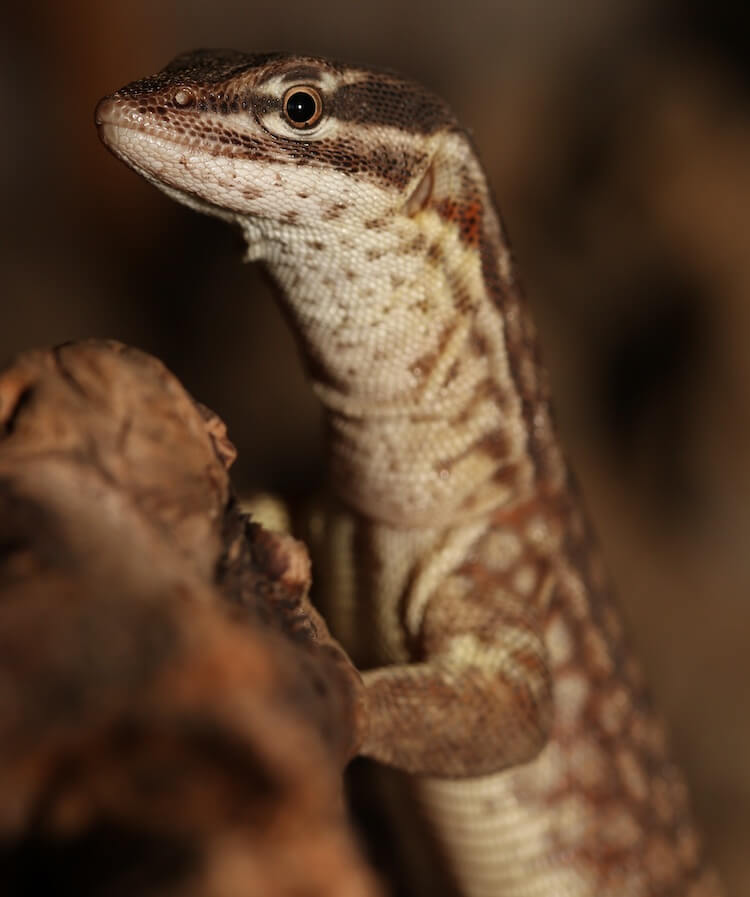
Ackie Monitors are a rewarding and unique pet for those who are up to the challenge! They require a large enclosure, high temperatures and a varied diet to thrive. They also need a keeper who is willing to make a long term commitment to their pet.
Feeding
Expect to go through a lot of insects when keeping this pet.
Ackies are fierce hunters that only eat meat. In their natural habitat they mostly eat insects like grasshoppers, crickets, beetles and cockroaches. They are also known to occasionally eat small lizards and eggs. They eat the same diet year-long and show have seasonal food preferences.
The best tip for feeding your pet Ackie is to provide variety of foods.
Variety provides enrichment for your lizard and also ensures that it is getting a complete diet with all of the necessary vitamins and minerals.
Ackies prefer live prey but can quickly adjust to eating dead or cooked food from tongs.
Regardless of if you are using live or dead prey, it should be dusted with a vitamin and calcium supplement powder twice weekly. This helps to maintain your lizard’s bone health.
Crickets, mealworms and Dubia cockroaches should be the main staple of an Ackie’s diet.
Adults can also be given an occasion treats like: mice, raw turkey, fish, or scrambled chicken eggs. This should only be once or twice a month and care should be taken to avoid overfeeding. This species easily becomes obese due to their appetite and willingness to eat anything.
| Age | Schedule | Food |
|---|---|---|
| 0 to 12 months | Daily | Crickets, mealworms and cockroaches |
| 12 to 24 months | 5 days a week | Insects and small mice (once a month) |
| 2 years + | 4 days a week | Insects, eggs, turkey and mice (once a month) |
Juveniles should be fed as much as they can eat within 10 minutes each day. Adults only need to eat four or five days a week.
It is important to keep track of your lizard’s weight. Young and growing Ackies are expected to gain weight, but the weight of individuals over two years old should not change significantly.
Health
Ackie monitors are normally strong and healthy lizards that live for between 15 and 20 years. They can suffer from health problems if not cared for properly and the three most common illnesses are:
- Parasites
- Obesity
- Metabolic bone disease
Many wild monitors carry parasites that they pick up through their diet. These worms can cause lethargy, weight loss and a reduced appetite. Pet Ackies are very rarely infected by parasites when fed a proper diet. You should never feed your monitor insects or other animals caught from the wild.
Pet species will easily become overweight if their diet is not carefully monitored. Healthy Ackie Monitors have a slim oval body shape when viewed from above. Obese individuals will start to look round. If a fully grown Ackie continues to gain weight then you are overfeeding them.
Metabolic bone disease is a bone condition that results from a lack of calcium in the blood. Always replace your monitor’s UVB bulb every six months and make sure its diet is high in calcium. Poor nutrition and a lack of UVB light leads to low calcium, which in turn triggers the release of calcium from the bone. This results in soft bones that fracture easily.
Behavior
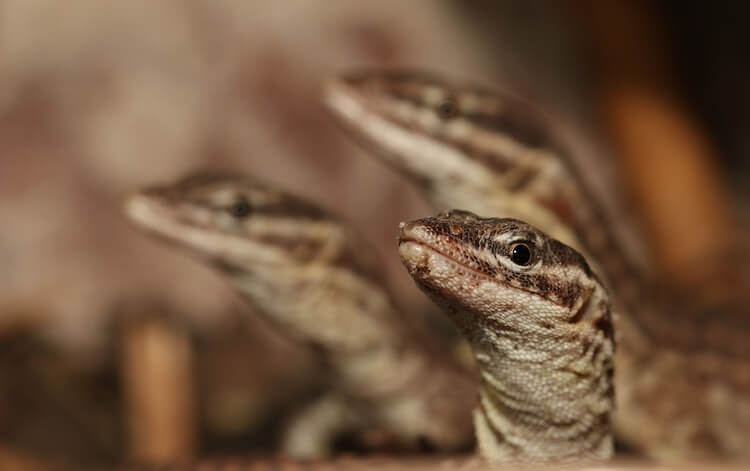
The Ackie monitor is a very active lizard that roams a large range. They are often found in small groups in the wild and so can be housed together in captivity with enough space.
If more than one is kept in a single enclosure, they will establish a dominance hierarchy. Dominant individuals may chase and attempt to bite other monitors, but this is generally play and not aggression. However, always keep an eye on individuals housed together and immediately separate them if any have injuries.
Ackies have long, curved claws that make them excellent climbers and diggers.
If threatened, Ackie monitors will attempt to run or burrow away from danger. If they are unable to escape, they will use their tails as a spiky club to ward off predators.
Pet species are easy to tame and rarely show aggression towards their owner if held gently and carefully.
Like all monitors, they are very intelligent and require a great deal of stimulation to stay happy.
An enclosure than encourages natural behaviors like digging and climbing will help to provide your monitor with enrichment. Bored monitors may be sedentary or develop repetitive behaviors like pacing, rubbing, or scratching at the walls of their enclosure.
Handling your lizard is also enriching, continue reading for some tips!
Handling
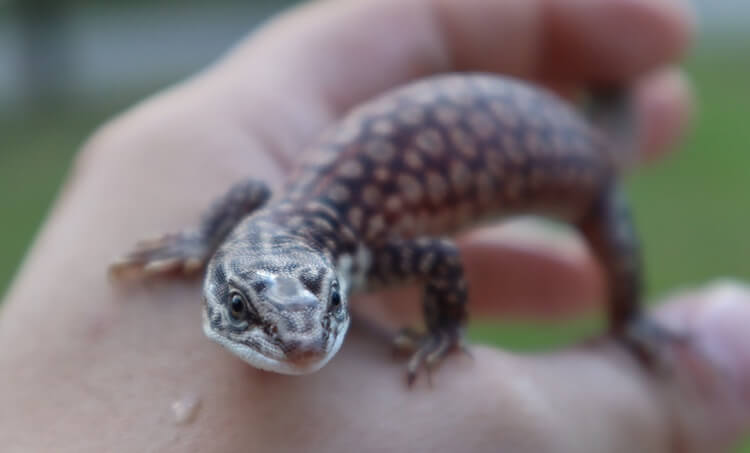
Ackie Monitors take well to handling, but they are initially more skittish than other common pets like Geckos. Patience is key to taming and holding.
Slowly introduce yourself by placing your hand in the enclosure and let your lizard come to you; it may take several weeks.
As with any lizard, patience and consistency are vital to forming a positive relationship.
With several weeks of slow introductions, Ackies usually take well to handling. If your Ackie enjoys it, handling is a great way to provide mental and physical exercise.
Once your monitor trusts you, they often initiate handling by approaching you. If this happens, pick up your lizard with a scooping motion and always support its whole body.
Are Ackie Monitors Good Pets?
The Ackie monitor is a perfect pet lizard for hobbyists looking to move into caring for an advanced species. These active and highly intelligent lizards need plenty of care, but provide years of entertainment and can form a strong bond with their keeper.
Two of the three subspecies of Ackie monitors are sold as pets; the yellow Ackie and the red Ackie.
Red Ackies grow slightly longer, are more expensive and not as common as yellow species.
Both species love to dig, climb, and explore, and can live for upto 20 years.
These lizards need at least a 125-gallon tank with one foot of substrate and plenty of branches, rocks, and plants to make them feel safe. In addition, they need a diet consisting mainly of insects but with mice, eggs, and raw poultry added occasionally for variation.

